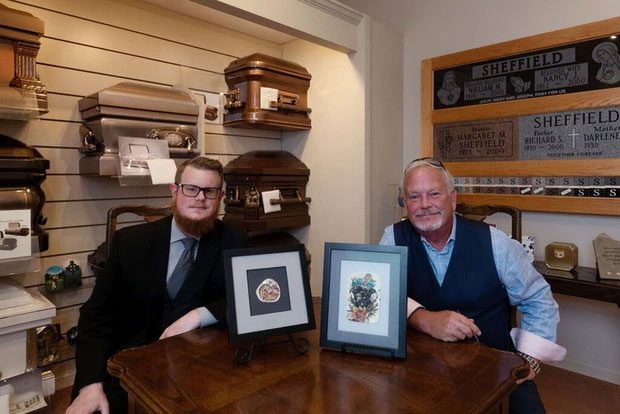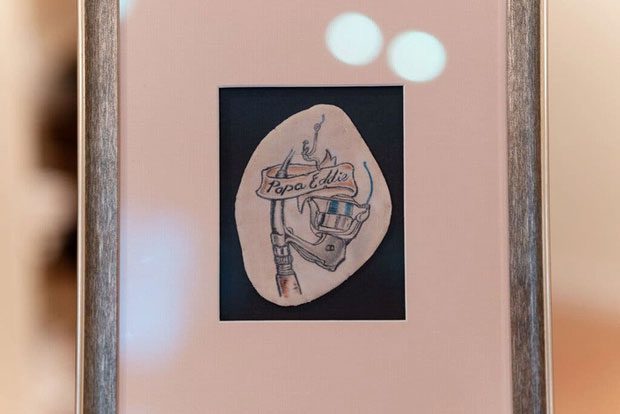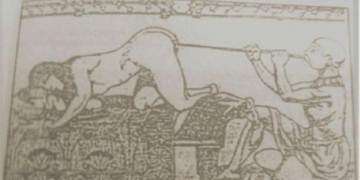Many Americans have come up with a unique way to preserve memories of their deceased loved ones.
Preserving a Part of a Deceased Loved One
Jonathan Gil knows he will never forget the details of the day his 24-year-old twin brother passed away in a canoeing accident on Lake Hopatcong in northern New Jersey—the frantic phone call from a friend, the agonizing search by rescue teams, and the horror of delivering the tragic news to his mother.
One thing that worried Gil was that as the months went by, the memories he held of Jason after that fateful day would begin to fade. His family’s solution: to preserve a part of their lost brother.
Now, whenever he seeks a quick reminder of his twin brother, Gil glances at a “picture” displayed on a shelf next to his desk, serving as a shrine, where a black-and-white skull tattoo and three roses—now preserved and framed—are part of Jason’s skin.
Gil, now 27, shared: “We have his ashes, but how can you see his physical form? With the tattoo, you can. It feels good to have a small piece of him; it feels like hugging him in a way and still keeping him close.“
The preserved tattoo is the work of a company in Ohio, founded in 2016 by Kyle Sherwood, a third-generation funeral director, and his father, Mike.
Although this somewhat unusual “trend” has been around for decades, very few companies offer professional services like the Sherwoods. Their idea stemmed from two things: First, more and more Americans are getting tattoos; and second, an increasing number of people want to preserve the tattoos of their deceased loved ones.
Many have had similar ideas, such as transforming the ashes of their loved ones into jewelry or glass sculptures—all aimed at keeping a part of the deceased for remembrance.
According to the National Funeral Directors Association, more families are inquiring about this service. Walker Posey, a funeral director and spokesperson for the association, states that over half of his approximately 400 clients each year ask about memorial items.
This marks a significant increase compared to five years ago when such requests were rare. Funeral laws in 49 states in the U.S.—with Washington being the exception—permit the practice of tattoo preservation.

Kyle Sherwood (left) and his father now operate a company specializing in this service.
Moreover, statistics show that 3 out of 10 Americans have at least one tattoo, according to a 2019 Ipsos poll, as the popularity of permanent ink continues to rise among the youth in the country.
While the concept of preserving tattoos of deceased loved ones remains scattered and unfamiliar, Sherwood has worked to refine the preservation process while treating tattoos as pieces of art (the ironing process to preserve details can take up to two years).
When the company receives a request for tattoo preservation, they send a package of materials to the funeral home to handle the “artwork.” Funeral directors are guided through a detailed video to carefully extract the necessary skin for preserving the tattoo. Sherwood admits: “This process is really difficult.” He notes that if something goes wrong, his team can often fix it.
The funeral director then needs to place the tattoo in a preserving solution. Next, it is sent to Ohio, where a team of about five people cleans, trims excess skin, and addresses any discoloration.
Sometimes, the skin is damaged. Or in the case of Gil’s brother’s waterlogged skin, additional care is needed to restore the tattoo to its original beauty.
Sherwood shares: “It’s like cleaning a dirty window.” He emphasizes that his team does not alter the tattoo in any way. He declines to disclose further details about the process, which takes about 3 to 4 months for each tattoo.
Ultimately, the tattoo will be framed. Families choose the type of frame and matting, and then a professional framer begins the work. Each tattoo is sewn onto fabric, and the frame is pumped with nitrogen to keep the tattoo preserved intact. Finally, a UV-protective glass used in museums is fitted in place to complete the process.
To perfect his skin handling techniques, Sherwood shared that he once had to pay for excess skin from surgeries to practice. The cost for this preservation service starts at $1,700 (over 41 million VND) for a 5×5 inch tattoo and can reach up to $120,000 (nearly 3 billion VND) for the largest pieces.
Sherwood notes that while some may find his business unusual, he takes pride in being able to provide people with a lasting memory of their loved ones.

A memorable tattoo that Sherwood once preserved for a mother to keep the memory of her deceased son alive.
The funeral director recounts the case of a man with tattoos of both his daughters’ names inside a heart. The family considered whether to save the tattoo, but Mr. Sherwood suggested cutting it in half like a friendship necklace so that each daughter would have a piece of their father.
In another case, he helped a grieving mother keep her son’s memory alive after he was murdered. The tattoo with the words “Papa Eddie” written on a scroll with a fishing rod was in memory of his grandfather. Notably, this tattoo was originally inked by the boy’s uncle. By preserving the tattoo, Sherwood stated that it not only represents her son but also symbolizes “a three-generation family.”
“The satisfaction and connection that I can create for people is indescribable. The impact on someone feels incredibly humbling and powerful.“
Tattoo Preservation is Not Just for the Deceased
Sherwood’s company has preserved a few tattoos for people who have lost limbs and recently received a new request from Asher J. Heart, who wants to keep a tattoo after undergoing gender transition surgery next year. Mr. Heart, 30, from Muskegon, Michigan, noted that the ink on his chest is no longer relevant, but it will become a tangible part of the person he once was.
“For me, it won’t erase my past; it will erase the pain of it.” Heart expressed.
For Gil, in addition to keeping his twin brother’s tattoo in a visible spot, he decided to honor him by getting two more tattoos—a portrait of Jason’s face and a replica of the glowing lantern tattoo that Jason had.
Gil mentioned that he also hopes those tattoos outlast him.
“I hope someone will do that for me.” Gil said. “I don’t need this when I leave. Once you pass away, that’s it. You don’t take anything with you.“





















































